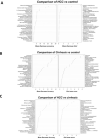Novel breath biomarkers identification for early detection of hepatocellular carcinoma and cirrhosis using ML tools and GCMS
- PMID: 37967076
- PMCID: PMC10651033
- DOI: 10.1371/journal.pone.0287465
Novel breath biomarkers identification for early detection of hepatocellular carcinoma and cirrhosis using ML tools and GCMS
Abstract
According to WHO 2019, Hepatocellular carcinoma (HCC) is the fourth highest cause of cancer death worldwide. More precise diagnostic models are needed to enhance early HCC and cirrhosis quick diagnosis, treatment, and survival. Breath biomarkers known as volatile organic compounds (VOCs) in exhaled air can be used to make rapid, precise, and painless diagnoses. Gas chromatography and mass spectrometry (GCMS) are utilized to diagnose HCC and cirrhosis VOCs. In this investigation, metabolically generated VOCs in breath samples (n = 35) of HCC, (n = 35) cirrhotic, and (n = 30) controls were detected via GCMS and SPME. Moreover, this study also aims to identify diagnostic VOCs for distinction among HCC and cirrhosis liver conditions, which are most closely related, and cause misleading during diagnosis. However, using gas chromatography-mass spectrometry (GC-MS) to quantify volatile organic compounds (VOCs) is time-consuming and error-prone since it requires an expert. To verify GC-MS data analysis, we present an in-house R-based array of machine learning models that applies deep learning pattern recognition to automatically discover VOCs from raw data, without human intervention. All-machine learning diagnostic model offers 80% sensitivity, 90% specificity, and 95% accuracy, with an AUC of 0.9586. Our results demonstrated the validity and utility of GCMS-SMPE in combination with innovative ML models for early detection of HCC and cirrhosis-specific VOCs considered as potential diagnostic breath biomarkers and showed differentiation among HCC and cirrhosis. With these useful insights, we can build handheld e-nose sensors to detect HCC and cirrhosis through breath analysis and this unique approach can help in diagnosis by reducing integration time and costs without compromising accuracy or consistency.
Copyright: © 2023 Ain Nazir et al. This is an open access article distributed under the terms of the Creative Commons Attribution License, which permits unrestricted use, distribution, and reproduction in any medium, provided the original author and source are credited.
Conflict of interest statement
The authors have declared that no competing interests exist.
Figures







Similar articles
-
Identification of phenol 2,2-methylene bis, 6 [1,1-D] as breath biomarker of hepatocellular carcinoma (HCC) patients and its electrochemical sensing: E-nose biosensor for HCC.Anal Chim Acta. 2023 Feb 15;1242:340752. doi: 10.1016/j.aca.2022.340752. Epub 2022 Dec 28. Anal Chim Acta. 2023. PMID: 36657885
-
Volatile organic compounds for diagnosis of early hepatocellular carcinoma in at-risk patients.Clin Chim Acta. 2024 Mar 15;556:117831. doi: 10.1016/j.cca.2024.117831. Epub 2024 Feb 18. Clin Chim Acta. 2024. PMID: 38378104
-
Confounding effect of benign pulmonary diseases in selecting volatile organic compounds as markers of lung cancer.J Breath Res. 2018 Sep 14;12(4):046013. doi: 10.1088/1752-7163/aad9cc. J Breath Res. 2018. PMID: 30102249
-
Detection technologies of volatile organic compounds in the breath for cancer diagnoses.Talanta. 2023 Dec 1;265:124767. doi: 10.1016/j.talanta.2023.124767. Epub 2023 Jun 5. Talanta. 2023. PMID: 37327663 Review.
-
Evidence of endogenous volatile organic compounds as biomarkers of diseases in alveolar breath.Ann Pharm Fr. 2013 Jul;71(4):203-15. doi: 10.1016/j.pharma.2013.05.002. Epub 2013 Jun 17. Ann Pharm Fr. 2013. PMID: 23835018 Review.
Cited by
-
Machine Learning Models and Applications for Early Detection.Sensors (Basel). 2024 Jul 18;24(14):4678. doi: 10.3390/s24144678. Sensors (Basel). 2024. PMID: 39066075 Free PMC article. Review.
-
Breath Analysis via Surface Enhanced Raman Spectroscopy.ACS Sens. 2025 Feb 28;10(2):602-621. doi: 10.1021/acssensors.4c02685. Epub 2025 Jan 17. ACS Sens. 2025. PMID: 39823225 Free PMC article. Review.
-
Non-Invasive Biomarkers and Breath Tests for Diagnosis and Monitoring of Chronic Liver Diseases.Diagnostics (Basel). 2024 Dec 30;15(1):68. doi: 10.3390/diagnostics15010068. Diagnostics (Basel). 2024. PMID: 39795596 Free PMC article. Review.
References
-
- Di Bisceglie A.M., et al.., Hepatocellular carcinoma. Annals of internal medicine, 1988. 108(3): p. 390–401. - PubMed
-
- Sherman M., et al.., Screening for hepatocellular carcinoma: the rationale for the American Association for the Study of Liver Diseases recommendations. 2012, Wiley Online Library. p. 793–796. - PubMed
MeSH terms
Substances
LinkOut - more resources
Full Text Sources
Medical
Miscellaneous

